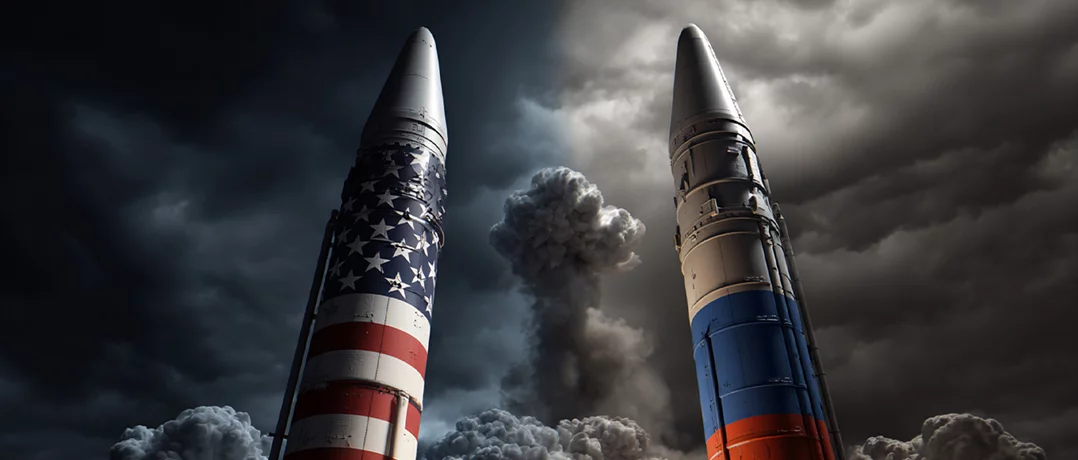The U.S. and Russia’s revived nuclear race heightens global tensions amid the ongoing Ukraine war.
The return of a nuclear arms race?

Nearly three and a half decades following the dissolution of the former Soviet Union (USSR), the nuclear arms race between Washington and Moscow seems to witness an alarming revival.
The aforementioned arms race, which began in 1945, witnessed phases of constructive engagement and de-escalation, known as “détente.” As the USSR dissolved in 1991, the Treaty on the Reduction and Limitation of Strategic Offensive Arms (START) was signed between the two major powers, the United States and Russia, limiting the number of ICBMs and nuclear warheads either country could possess.
The ongoing Russia-Ukraine War, however, has ignited nuclear concerns that the world’s population has long believed to have been forgotten. What was once inconceivable has recently become a dangerous reality.
The Russian-American renewed nuclear race
On October 27, 2025, Russian President Vladimir Putin announced that Moscow has held nuclear drill and launched a successful test of an atomic-powered cruise missile, the “Burevestnik” (which means “storm petrel” in Russian, and code-named “Skyfall” by NATO). Moscow claimed that it cannot be intercepted by air defenses. Consequently, on October 29, 2025, Putin claimed that his country has conducted a successful test of a new atomic-powered and nuclear-capable underwater drone, named “Poseidon.” The two pioneering announcements were presented as a means of guaranteed retaliation to a first strike. They also came following Trump’s cancelation of his summit with Putin in Bucharest, Hungary, while simultaneously criticizing Moscow’s “senseless war” on Ukraine.
In retaliation, the US President Donald Trump announced that his country will resume testing its nuclear arsenal “immediately.” This came ahead of his meeting with Chinese President Xi Jinping in South Korea. The President claimed that “due to tests conducted by other countries, I have instructed the Department of War to begin testing our nuclear weapons likewise.”
These are not the first measures taken by the two powers. Just as the Russia-Ukraine War erupted on February 22, 2022, numerous nuclear agreements were either terminated or were not renewed. A perfect example would be the New START Treaty. It was signed on April 8, 2010, in Prague and was expected to expire on February 4, 2026. However, in February 2023, President Putin announced that Moscow suspending its participation. Suspension, however, does not terminate the agreement, as in the case of withdrawal, thus leaving room for its possible reactivation. Another example is the Plutonium Management and Disposition Agreement (PMDA) signed in 2000. Just this earlier this month, Russia’s lower-house State Duma voted to fully withdraw from the agreement with the US, citing Washington’s support for Ukraine, NATO’s expansion in Eastern Europe and US departure from the original terms of plutonium disposal.
US approves the building of a South Korean nuclear submarine
President Trump’s Southeast Asian visit has witnessed numerous trade deals. From Tokyo to Seoul, the US managed to secure vital trade agreements amidst a tense confrontation with China. However, this was not the only the president had in mind.
During his visit to South Korea, Trump announced that he “gave them the approval to build a nuclear-powered submarine, instead of the older, slower diesel-powered submarines that they currently have.” In this regard, South Korean President Lee Jae-myung claimed that “we do not propose building submarines armed with nuclear weapons, but diesel-powered submarines have less endurance under water, which limits our ability to track North Korean or Chinese submarines.” This approval is therefore seen as a strategic threat to North Korea and even China, two staunch allies of Russia. The two have been aiding Russia evade western sanctions, while Pyongyang has even sent troops to the battlefield to assist Moscow in its war efforts.
Hence, Trump’s announcement would exacerbate existing tensions in the region, threatening neighboring countries’ stability and security (including Russia).



